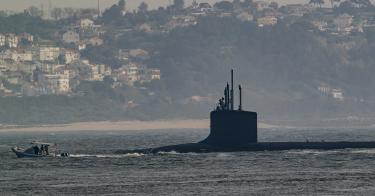Everyone in Washington talks about how we need to expand the defense industrial base, especially our shipbuilding capacity. But some conservatives in Congress aren’t willing to put their money where their mouth is.
The latest example of this is the House Appropriations Committee’s new draft defense spending bill. Incredibly, the House Appropriations Committee is siding with the Administration on funding only one new Virginia-class submarine, despite the rest of the House moving to authorize two subs.
Worse still, the Committee can’t claim to be motivated by a sense of fiscal responsibility. The draft cuts procurement spending, but it increases spending in other areas, such as research and development spending, and includes a host of secondary priorities that could have been cut instead of real military capabilities like warships. This isn’t some minor adjustment, it’s a significant, directional change from what most of the House is supporting.
>>> It’s Past Time to Re-Supply Our Munitions-Depleted U.S. Navy
There’s already an imbalance between procurement and research and development within the defense budget, with far too little money being spent on buying new ships, planes, and munitions. Consider that in the 1980s procurement spending was roughly double that of research and development, whereas now they’re nearly the same.
The draft appropriations bill wants to spend $165.3 billion for procurement ($1.4 billion below the administration’s request) and $145.9 billion in research and development (a $2.7 billion increase). This follows a pattern on the committee, which last year slashed procurement by roughly $4 billion—including precision-guided munitions that would be critical in a war in the Pacific—and increased research and development by $1.9 billion.
When criticized, the Republican-led House Appropriations Committee doubles down. They insist that to expand the defense industrial base, we should buy fewer ships and munitions over the next several years thus giving the industry time to build infrastructure for future orders and to clear up the current backlog.
Neither of these objections stand up to scrutiny. Additional orders send a long-term demand signal and give industry the capital it needs to invest in labor and facilities, and the idea of a backlog is a secondary or even tertiary concern when compared with the primary goal of building a bigger fleet.
Cutting funding for a second submarine is especially egregious. A bipartisan letter signed by over a hundred congressmen argued in favor of two submarines, saying the planned growth in submarine production is “dependent on the persistent two-per-year demand signal to the nationwide submarine industrial base that Congress has defended since 2011,” a commitment that has “driven suppliers to make critical capital investments and expand capacity based on a predictable forecast in expected work.”
>>> Navy Inactive Fleet Has Life Still: Expeditionary Transfer Docks Should Be Returned to Service
Funding just one submarine also falls short of the long-term shipbuilding plans of the U.S. Navy, puts at risk the planned sales of Virginia-class submarines to Australia as part of the AUKUS deal, and weakens the demand signal that the shipbuilding industry needs to invest in capacity and labor for future submarine construction.
This should be especially concerning to people who support the deal to sell Virginia-class submarines to Australia. As former Trump administration official Elbridge Colby and others have noted, even though it is highly desirable for the U.S. to send nuclear submarines to Australia, our own underinvestment in the fleet could potentially put the deal at risk. If the U.S. can’t meet its own capacity needs, it will be difficult to justify the sale.
Senator Roger Wicker, Ranking Member on the Senate Armed Services Committee, clearly understands that more procurement is needed to send a strong demand signal to industry and expand the defense industrial base. The senator recently rolled out a plan to increase defense spending by $55 billion, with a focus on expanding munitions and warship procurement and production capacity. The Heritage Foundation likewise has supported a two submarine minimum per year, both in the Index of U.S. Military Strength and the Fiscal Year 2025 Conservative Defense Budget.
Funding only one submarine is a failure to align defense spending with defense strategy at a time when the need for a strong U.S. Navy in the Indo-Pacific is more important than ever. Now is not the time to cut shipbuilding, and the House Appropriations Committee should fund what the rest of the House is authorizing.
This piece originally appeared in RealClear Defense





